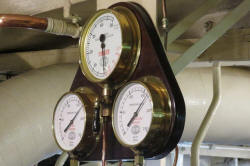Strand 1: Praise
 |
I can live for two
months on a good compliment. Mark Twain (1835-1910) |
You arrived here because you either agreed or fully agreed with one of the following statements:
I use a lot of praise such as ‘Wonderful’, ‘Terrific’, ‘Great answer’ and so on because I want to motivate my learners
I try to avoid too much praise and just nod or say ‘OK’ when something is correct
Everyone needs to be told when they have done a good job and we all like a good compliment. Nevertheless, how and when we praise our students is not as straightforward as it may seem.
 |
Praise or Feedback? |
You may think that praise is a form of feedback, and you'd be right but it's a peculiar form of feedback because it often goes nowhere. Consider these four classroom interactions:
| T:
What did you do last night? S: I went to see that film. T: Really!? That's great. What did you think? |
T:
What did you do last night? S: I went to see that film. T: Terrific. Really good. That's excellent. |
| T:
What did you do last night? S: I go to see that film. T: Really!? That's great. You go or you went? S: Oh, I went. T: Fine. What did you think? |
T:
What did you do last night? S: I go to see that film. T: Tense? S: I went to see that film T: Terrific. Really good. That's excellent. |
On the left we have praise
and feedback. On the right, it's just praise
with almost no feedback. If you were the student,
which would you respond to more positively?
Right. Above and beyond praise (which is always nice)
we need to feel that the teacher is listening to what we
say, as well as how we say it.
Overusing praise cheapens the coinage. If everything is "Great", what do you say when it really is exceptional?
Underusing praise demotivates and confuses. If every answer is greeted with "OK" how do I know if it's right or wrong, good, passable or excellent?
There is some anecdotal and research evidence to suggest that learners appreciate feedback more than they appreciate praise. A lot of the research that has been done is based on 'ordinary' schools, often elementary ones, rather than in language-teaching environments but it's interesting nonetheless. Here's a quick summary of some tidbits of research:
- Teachers' and students' perceptions of the purpose of praise differ. (Morine-Dershimer, 1982)
- "Praise is positive reinforcement that contains positive affect and is a more intense response to student behavior than general feedback" (Thomas (1991) and Blote (1995) in Reigel, 2008)
- "even in a classroom, where a teacher praises once every five minutes, the rate of praise for the average student would be ... once every two hours" (Brophy (1981:10) also in Reigel, 2008)
- "students may value explicit feedback relating directly to a given response (Ellis, 2008) and it is possible that this ‘general’ praise lacks the specificity that is valued by students." (Levy, 2014)
- "Scrivener has recently questioned what he describes as empty praise’ or ‘overpraising’ and has suggested that continual praise, as opposed to feedback, actually hinders the learning process (Scrivener, 2012)" (Levy, op cit.).
A classroom research suggestion
Given that there really isn't very much ELT-specific research concerning the effects of praise, why not do some of your own? ELT Concourse might be interested in publishing your results here.
This is a six-phase suggestion based on the work of Levy (op cit.).
Phase 1: Reflection and estimation
Make a list of the praise words you use most often in class and guess how often you use them. Here are some suggestions:
good, very good,
yep/yes/yeah, well done, perfect, exactly, fine, great,
excellent etc.
Add your own favourites to the list and omit the ones you
never use.
Phase 2: The reality
Now record one or two lessons and, when you listen to / watch it, record how often you actually used the praise words. Set the results out in a table and compare how often you really used them with how often you thought you used them.
Then listen to the lesson again and record when you used the words and what was happening at the time. This may take a bit of time but you will end up with a graph something like this:

From that, you can easily see which words you are overusing and which you hardly ever use.
Phase 3: Praise, feedback or both?
Now listen again to see how often you combined praise with solid feedback and record the results. You'll end up with a list of words with the percentage of the time they were used with feedback so you can see whether you are just praising or praising and giving feedback on form and content.
Phase 4: Learner response
This is a bit more subjective, but none the worse for
that.
Now try to see if you can recall the learners' reactions to
your praise and/or feedback.
Did the praise just wash over them or were they more engaged
by it?
Did they take the feedback on board and amend their language
independently?
Phase 5: Evaluating outcomes
Here's where you sit and think. What conclusions do you draw? Can you answer these questions?
- Do you overuse extreme praise words such as Wonderful?
- Do you underuse praise?
- Do you give feedback without praise too much?
- Do you give praise without feedback too much?
- Could you combine praise with feedback more often?
Phase 6: Amending your behaviour
From the results of all the above, you should be able to set out an action plan for how to change your classroom routines and be more sure that you are giving feedback appropriately, not using praise so much that you cheapen the coinage and your learners begin to ignore it and not using it too little so that the learners don't believe you are valuing their efforts.
When you have done that, try recording another lesson or two and running the same analysis.
Here's how the whole thing might look:

 |
Gauging progress |
There's a separate guide in this section of the site to
gauging and measuring progress in your
development. Go there for more ideas.
In terms of responding to learners' contributions, you may not
always be the best judge so, if you can, get someone to observe how you react
to contributions and ideas and discuss whether your reaction was the right one.
If it wasn't, try to think together about what would have been the right
response.
References:
Levy, K, 2014, Verbal Praise in the Classroom: An
Exploratory Research Study, ELT Research Issue 29 (January 2014)
IATEFL Research SIG (resig.iatefl.org)
Morine-Dershimer, G, 1982, Pupil Perceptions of Teacher Praise,
The Elementary School Journal, Vol. 82, No. 5, Special
Issue: Students in Classrooms, pp. 421-434, Chicago: The
University of Chicago
Reigel, D, 2008, Positive Feedback in Pairwork and Its Association with
ESI Course Level Promotion, TESOL Quarterly, Vol. 42,
No. 1, pp. 79-98, Teachers of English to Speakers of Other
Languages, Inc. (TESOL)
